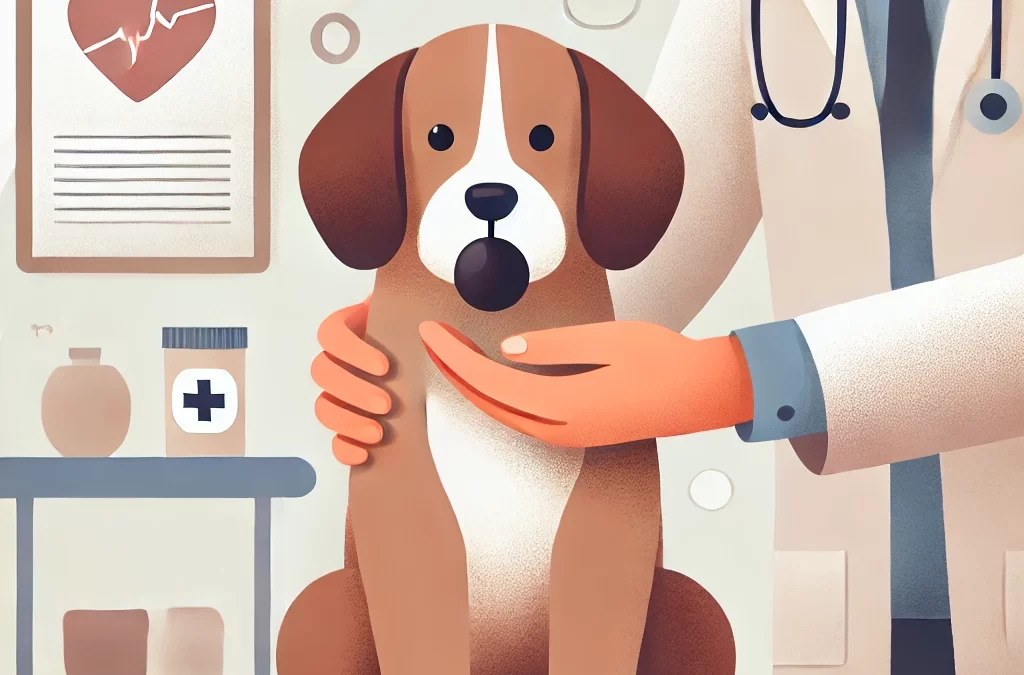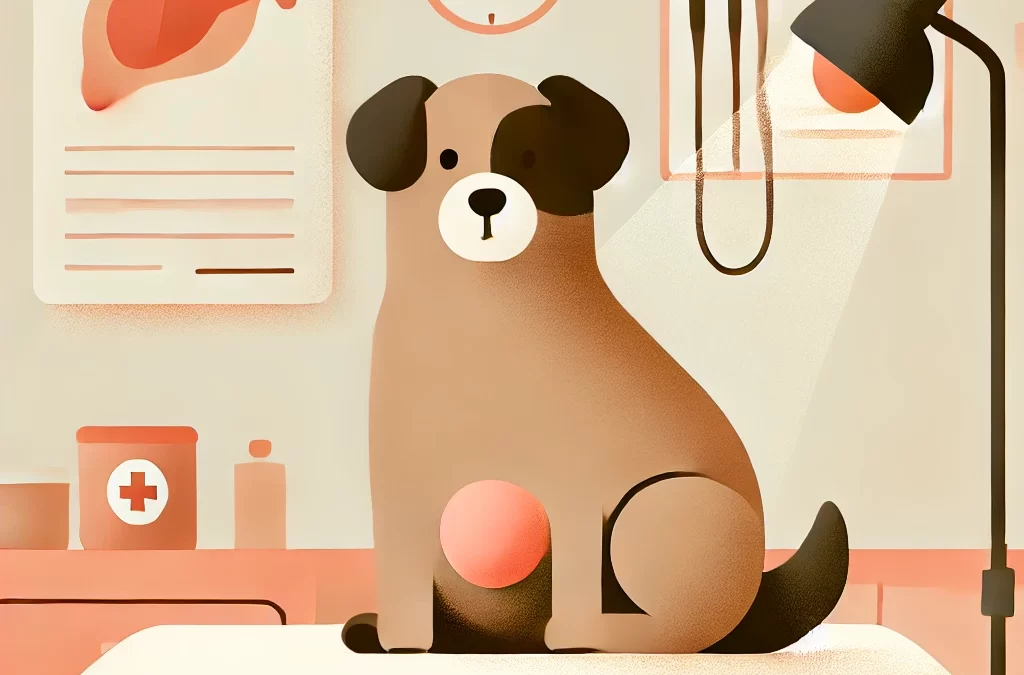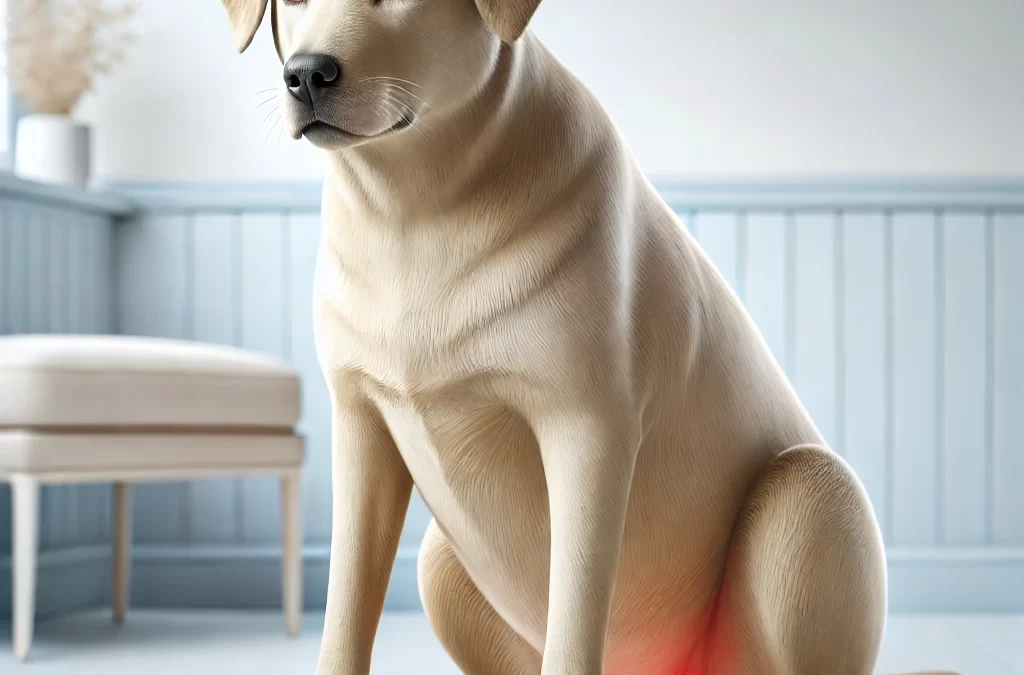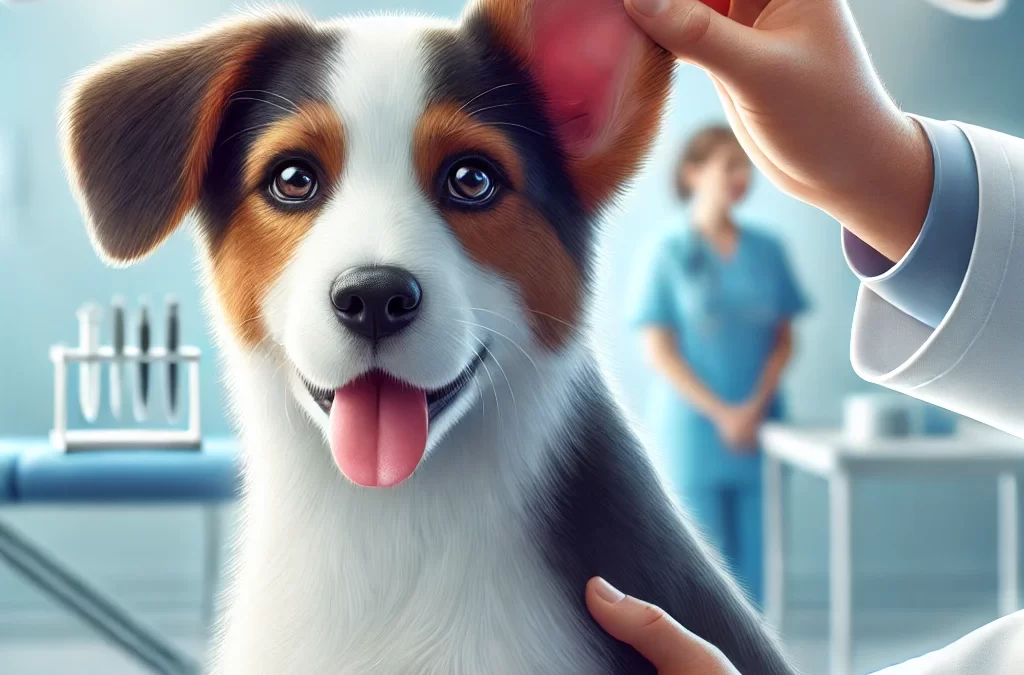
von TCMVET | 18. Dez. 2024 | Krebs und Tumore bei Hunden
Lymphome sind eine der häufigsten Krebserkrankungen bei Hunden. Obwohl sie oft mit Behandlungen wie Chemotherapie behandelt werden können, kommt irgendwann der Punkt, an dem die Krankheit trotz aller Eingriffe fortschreiten kann. Wenn Sie die Anzeichen dafür erkennen, dass Ihr Hund sich dem Ende seiner Krankheit nähert, können Sie ihm Trost spenden und fundierte Entscheidungen über seine Pflege treffen. Hier finden Sie eine Anleitung zum Erkennen der Anzeichen von Lymphomen im Spätstadium und wie Sie Ihr geliebtes Haustier in dieser schwierigen Zeit unterstützen können.
Hunde-Lymphom verstehen
Lymphome betreffen das Lymphsystem, das Teil des Immunsystems ist. Sie können sich in verschiedenen Körperteilen manifestieren, darunter in den Lymphknoten, der Milz, der Leber und dem Magen-Darm-Trakt. Der Krankheitsverlauf ist unterschiedlich, aber mit fortschreitendem Krankheitsverlauf wird der Körper zunehmend beeinträchtigt, was zu erheblichen körperlichen und Verhaltensänderungen führt.
Anzeichen dafür, dass Ihr Hund an Lymphom sterben könnte
Starke Müdigkeit und Lethargie
Hunde mit fortgeschrittenem Lymphom zeigen oft extreme Müdigkeit. Ihr einst aktives Haustier verbringt möglicherweise den Großteil des Tages schlafend oder liegend und zeigt kaum noch Interesse an Aktivitäten, die ihm früher Spaß gemacht haben.
Atembeschwerden
Lymphome im Brustkorb können zu Flüssigkeitsansammlungen um die Lunge führen, was Ihrem Hund das Atmen erschwert. Anzeichen sind schnelles Atmen, flaches Atmen oder mühsame Anstrengung.
Appetitverlust
Ein sterbender Hund kann sich weigern, zu essen oder zu trinken, was darauf hinweist, dass sein Körper versagt. Sogar seine Lieblingsleckereien bleiben möglicherweise unangetastet.
Gewichtsverlust und Muskelschwund
Im weiteren Krankheitsverlauf kommt es zu deutlichem Gewichtsverlust und Muskelschwund (Kachexie). Die Rippen und die Wirbelsäule des Hundes können ausgeprägter werden.
Geschwollene Lymphknoten
Obwohl geschwollene Lymphknoten ein typisches Zeichen für Lymphome sind, kann ihre Größe im Endstadium der Erkrankung dramatisch zunehmen.
Erbrechen und Durchfall
Wenn das Lymphom den Magen-Darm-Trakt befällt, kann Ihr Hund chronisches Erbrechen, Durchfall oder beides haben. Diese Symptome können zu Dehydrierung führen und den Körper weiter schwächen.
Schmerzen und Beschwerden
Ihr Hund kann Anzeichen von Schmerzen zeigen, wie z. B. Wimmern, Schwierigkeiten beim Hinlegen oder Bewegungsunlust. Schmerzen können durch Organschäden, Entzündungen oder Druck durch Tumore verursacht werden.
Verhaltensänderungen
Gegen Ende ihres Lebens ziehen sich Hunde oft zurück. Sie vermeiden möglicherweise Interaktionen, suchen die Einsamkeit oder wirken desorientiert.
So unterstützen Sie Ihren Hund in dieser Zeit
Konsultieren Sie Ihren Tierarzt, um sicherzustellen, dass Ihr Hund eine angemessene Schmerzbehandlung und Palliativversorgung erhält. Medikamente wie Mittel gegen Übelkeit, Appetitanreger und Schmerzmittel können das Wohlbefinden Ihres Hundes verbessern.
Schaffen Sie eine ruhige und friedliche Umgebung, in der Ihr Hund ungestört ruhen kann. Sorgen Sie für eine weiche Unterlage und halten Sie seine Lieblingsgegenstände in der Nähe.
Bieten Sie Ihrem Hund kleine Mengen leicht verdaulicher Nahrung an, wenn er bereit ist, zu fressen. Auch die Flüssigkeitszufuhr ist wichtig, zwingen Sie ihn jedoch nicht zum Trinken.
Verbringen Sie wertvolle Zeit mit Ihrem Haustier und schenken Sie ihm liebevolle Zuneigung und Zuspruch. Ihre Anwesenheit kann sowohl Ihnen als auch Ihrem Hund großen Trost spenden.
Erwägen Sie eine humane Euthanasie, wenn die Lebensqualität Ihres Hundes deutlich nachlässt. Auch wenn dies eine schwierige Entscheidung ist, kann es eine mitfühlende Möglichkeit sein, das Leiden Ihres Hundes zu lindern.
Abschluss
Wenn Sie die Anzeichen dafür erkennen, dass Ihr Hund möglicherweise an Lymphom stirbt, können Sie sich auf sein Wohlbefinden und seine Gesundheit konzentrieren. Jeder Hund hat einen einzigartigen Lebensweg und Ihre Liebe und Fürsorge während dieser Zeit werden in seinen letzten Tagen einen großen Unterschied machen.

von TCMVET | 18. Dez. 2024 | Krebs und Tumore bei Hunden
Einleitung: Der stille Feind bei der Behandlung von Krebs bei Hunden
Krebskachexie, ein komplexes metabolisches Syndrom, das durch starken Gewichtsverlust und Muskelschwund gekennzeichnet ist, ist eine stille, aber tödliche Erkrankung, die viele krebskranke Hunde betrifft. Kachexie wird oft von der Grunderkrankung überschattet und beeinträchtigt die Lebensqualität, das Ansprechen auf die Behandlung und das Gesamtüberleben der betroffenen Haustiere erheblich. Das Verständnis und die Behandlung dieser Erkrankung sind für eine ganzheitliche Krebsbehandlung bei Hunden von entscheidender Bedeutung.
What is Cancer Cachexia?
Krebskachexie ist mehr als nur Gewichtsverlust. Es ist eine multifaktorielle Erkrankung, die durch das Zusammenspiel von systemischer Entzündung, Stoffwechselstörungen und den Stoffwechselanforderungen des Tumors verursacht wird. Zu den wichtigsten Merkmalen gehören:
- Verlust von Muskelmasse: Anders als beim einfachen Hungern kommt es bei Kachexie zu Muskelschwund, der sich allein durch eine erhöhte Kalorienzufuhr nicht rückgängig machen lässt.
- Appetite Changes: Hunde können ein vermindertes Interesse am Futter (Anorexie) oder veränderte Geschmacksvorlieben zeigen.
- Systemische Entzündung: Durch den Tumor verursachte Entzündungen verschärfen Stoffwechselstörungen und verschlechtern den Zustand weiter.
Warum tritt bei Hunden Krebskachexie auf?
Die genauen Mechanismen der Krebskachexie sind komplex und variieren je nach Krebsart und -stadium. Zu den Faktoren, die zu dieser Erkrankung beitragen, gehören:
- Tumor Metabolism: Bestimmte Tumore scheiden Substanzen aus, die normale Stoffwechselprozesse stören und Muskel- und Fettabbau verursachen.
- Zytokine und Hormone: Erhöhte Werte entzündungsfördernder Zytokine (z. B. TNF-Alpha) und hormonelle Ungleichgewichte spielen eine entscheidende Rolle bei der Entstehung von Kachexie.
- Nährstoffmangel: Eine verringerte Nahrungsaufnahme und eine gestörte Nährstoffaufnahme verschlechtern den Zustand des Hundes.
Krebskachexie bei Hunden erkennen
Eine frühzeitige Erkennung ist der Schlüssel zur Behandlung einer Krebskachexie. Achten Sie auf diese Anzeichen:
- Unerklärlicher Gewichtsverlust trotz ausreichender Nahrungsaufnahme
- Muskelschwund, insbesondere im Bereich der Wirbelsäule und der Hinterbeine
- Müdigkeit und reduziertes Aktivitätsniveau
- Veränderungen des Appetits oder des Essverhaltens
Innovative Managementstrategien
Obwohl es keine Universallösung gibt, kann ein multimodaler Ansatz helfen, Kachexie bei Hunden zu behandeln. Hier sind einige neue Strategien:
- Individuelle Ernährungsunterstützung: Eine Ernährung, die reich an hochwertigen Proteinen, Omega-3-Fettsäuren und bestimmten Aminosäuren wie Glutamin ist, kann zum Erhalt der Muskelmasse beitragen.
- Appetite Stimulants: Medikamente wie Mirtazapin oder Capromorelin können den Appetit und die Nahrungsaufnahme verbessern.
- Anti-Inflammatory Therapies: Omega-3-Ergänzungsmittel und Medikamente, die auf Entzündungsprozesse abzielen, können die Zytokinaktivität verringern.
- Stoffwechselmodulatoren: Die Forschung an Medikamenten wie Anamorelin und Ghrelin-Mimetika verspricht eine Umkehrung des Muskelschwunds.
Die Rolle der Integrativen Medizin
Natürliche Therapien wie die Traditionelle Chinesische Medizin (TCM) haben sich als wirksam bei der Linderung der Symptome erwiesen. Kräuter wie Tragant und Ginseng können die Immunfunktion und das Energieniveau unterstützen, während Akupunktur den Appetit steigern und Entzündungen reduzieren kann.
Ausblick: Bedarf an weiterer Forschung
Trotz Fortschritten ist die Krebskachexie in der Veterinärmedizin noch immer unzureichend erforscht. Die Zusammenarbeit zwischen Tierärzten, Forschern und Tierbesitzern ist unerlässlich, um neue Therapien zu entwickeln und die Behandlungsergebnisse für betroffene Hunde zu verbessern.
Fazit: Hoffnung durch Innovation
Obwohl Krebskachexie eine große Herausforderung darstellt, geben Fortschritte im Verständnis und in der Behandlung dieser Krankheit Anlass zu Hoffnung. Durch einen ganzheitlichen und proaktiven Ansatz können wir die Lebensqualität von Hunden, die gegen Krebs kämpfen, verbessern und ihnen helfen, ihre goldenen Jahre in Würde und Komfort zu genießen.

von TCMVET | 16. Dez. 2024 | Krebs und Tumore bei Hunden
Das orale maligne Melanom (OMM) bei Hunden ist ein heimtückischer Gegner. Es ist für seine aggressive Natur und schnelle Verbreitung bekannt und eine Diagnose, die Tierbesitzern Angst einjagt. Aber OMM ist mehr als nur eine Krankheit – es ist ein Aufruf an Tierbesitzer, wachsam zu sein, innovativ zu sein und eine ganzheitliche Pflege zu übernehmen. Lassen Sie uns dieses herausfordernde Thema mit einem frischen Blick betrachten und sowohl die Wissenschaft als auch die Hoffnung erkunden.
Was ist ein malignes orales Melanom?
Das orale maligne Melanom ist eine Krebsart, die in den Melanozyten entsteht – Zellen, die für die Pigmentproduktion in der Haut und den Schleimhäuten verantwortlich sind. Obwohl es am häufigsten im Mund auftritt, ist dieser Krebs nicht dort allein. Er ist dafür bekannt, dass er in benachbartes Gewebe eindringt und in entfernte Organe wie die Lunge und die Lymphknoten metastasiert.
Diese Erkrankung tritt am häufigsten bei Hunden mittleren bis höheren Alters auf, insbesondere bei Rassen mit dunkel pigmentiertem Zahnfleisch wie Cocker Spaniels, Chow-Chows und Scottish Terriern. Trotz des düsteren Rufs der Erkrankung können Besitzer fundierte Entscheidungen treffen, wenn sie die Anzeichen und Behandlungsmöglichkeiten von OMM kennen.
Die Zeichen erkennen
Das maligne Melanom in der Mundhöhle bleibt oft unbemerkt, bis es fortgeschritten ist. Daher sind regelmäßige Kontrolluntersuchungen unerlässlich. Häufige Anzeichen sind:
- Eine dunkle oder unregelmäßige Masse im Mund, Zahnfleisch oder an den Lippen.
- Blutungen, Mundgeruch oder Speichelfluss.
- Schwierigkeiten beim Essen, Kauen oder Schlucken.
- Gesichtsschwellung oder vergrößerte Lymphknoten.
Wenn Sie eines dieser Symptome bemerken, wenden Sie sich sofort an Ihren Tierarzt. Eine frühzeitige Erkennung kann den Ausgang erheblich beeinflussen.
Über traditionelle Behandlungen hinaus: Innovationen begrüßen
Zu den herkömmlichen Behandlungsmethoden für OMM gehören Operationen, Strahlentherapie und Chemotherapie. Diese Optionen sind zwar in vielen Fällen wirksam, aber nicht immer zugänglich oder erschwinglich. Hier sind einige innovative und integrative Ansätze, die zunehmend Aufmerksamkeit erregen:
- Immuntherapie-Impfstoffe: OMM-spezifische Impfstoffe wie der Hundemelanom-Impfstoff (ONCEPT®) sind ein bahnbrechender Fortschritt in der Onkologie und stimulieren das Immunsystem des Hundes, um Krebszellen zu bekämpfen. Diese hochmoderne Behandlung hat sich als vielversprechend für die Verlängerung der Überlebenszeit erwiesen.
- Photodynamische Therapie (PDT): Bei dieser Technik werden lichtaktivierte Medikamente eingesetzt, um Krebszellen gezielt zu zerstören und das umliegende gesunde Gewebe zu schonen. In manchen Fällen ist dies eine weniger invasive Methode.
- Ganzheitliche Ergänzungsmittel: Natürliche Nahrungsergänzungsmittel wie Curcumin (in Kurkuma enthalten), Heilpilze und Omega-3-Fettsäuren werden auf ihre entzündungshemmenden und immunstärkenden Eigenschaften untersucht. Konsultieren Sie immer einen Tierarzt, bevor Sie Nahrungsergänzungsmittel verabreichen.
Die Rolle der Ernährung bei der Genesung
Eine Krebsdiagnose erfordert eine Änderung der Ernährungsstrategie. Hunde, die an OMM leiden, profitieren von einer Ernährung, die auf ihre Stoffwechselbedürfnisse abgestimmt ist. Konzentrieren Sie sich auf:
- Hochwertige Proteine: Mageres Fleisch und Fisch zum Erhalt der Muskelmasse.
- Gesunde Fette: Omega-3-Fettsäuren bekämpfen Entzündungen und unterstützen die allgemeine Gesundheit.
- Kohlenhydratarme Optionen: Krebszellen leben von Zucker. Eine Einschränkung der Kohlenhydratzufuhr kann ihr Wachstum verlangsamen.
Selbst zubereitete, vom Tierarzt empfohlene Mahlzeiten können eine gute Möglichkeit sein, um sicherzustellen, dass Ihr Hund eine optimale Ernährung erhält.
Emotionale und praktische Unterstützung für Tierbesitzer
Die Pflege eines Hundes mit OMM ist sowohl emotional als auch emotional anspruchsvoll. So meistern Sie diesen Weg:
- Erstellen Sie eine tägliche Pflegeroutine: Durch die Herstellung von Beständigkeit können Sie und Ihr Hund den Stress reduzieren.
- Suchen Sie nach Community-Unterstützung: Online-Foren und lokale Selbsthilfegruppen für Tierbesitzer, die an Krebs bei Hunden leiden, können Trost und wertvolle Erkenntnisse bieten.
- Entdecken Sie die Möglichkeiten der Palliativversorgung: Wenn eine kurative Behandlung nicht in Frage kommt, konzentrieren Sie sich auf die Schmerzbehandlung und die Verbesserung der Lebensqualität Ihres Hundes.
Ein Hoffnungsschimmer
Während das orale maligne Melanom bei Hunden ein gewaltiger Feind ist, ändern Fortschritte in der Veterinärmedizin und der integrativen Pflege die Situation. Früherkennung, innovative Behandlungen und ein Fokus auf ganzheitliches Wohlbefinden befähigen Tierbesitzer, diese Krankheit zu bekämpfen.
Die Diagnose Ihres Hundes definiert nicht die Reise – sie ist ein Kapitel in der Geschichte seiner Widerstandskraft, Liebe und der Bindung, die Sie teilen. Stellen Sie weiterhin Fragen, suchen Sie nach Lösungen und genießen Sie jeden Moment.

von TCMVET | 16. Dez. 2024 | Krebs und Tumore bei Hunden
Einen Knoten am Bauch Ihres Hundes zu entdecken, kann beunruhigend sein. Als Tierbesitzer sind wir instinktiv oft besorgt – aber nicht alle Knoten sind gefährlich. Tatsächlich sind viele gutartig und mit der richtigen Pflege beherrschbar. Um Ihnen dabei zu helfen, mit dieser Situation umzugehen, finden Sie hier eine neue Perspektive zum Verständnis, Erkennen und Behandeln von Magenknoten bei Hunden.
Was genau ist ein Knoten im Magen?
Ein Magenklumpen bei Hunden ist eine abnorme Masse oder Schwellung im Bauchbereich. Diese können in Größe, Form und Beschaffenheit variieren – manche fühlen sich weich und beweglich an, während andere fest sein oder an darunterliegendem Gewebe haften können.
Der Schlüssel zur Behandlung solcher Knoten liegt in der Beobachtung und rechtzeitigen Reaktion. Bevor wir voreilige Schlüsse ziehen, wollen wir die häufigsten Ursachen für diese Wucherungen untersuchen.
Häufige Ursachen für Magenklumpen
- Lipome (Fettgeschwülste): Dabei handelt es sich um gutartige, weiche und langsam wachsende Knoten, die häufig bei älteren Hunden auftreten. Lipome stellen selten ein Gesundheitsrisiko dar und sind in der Regel eher ein kosmetisches Problem.
- Hämatome oder Abszesse: Wenn Ihr Hund vor Kurzem ein Trauma erlitten hat, könnte es sich bei der Schwellung um ein Hämatom (eine Blutansammlung unter der Haut) oder einen durch eine Infektion verursachten Abszess handeln. Diese sind bei Berührung oft warm und empfindlich.
- Hernien: Hernien entstehen, wenn innere Gewebe oder Organe durch eine schwache Stelle in der Bauchdecke drücken. Sie können sich weich anfühlen und bei leichtem Druck wieder zurückgehen.
- Bösartige Tumore: Leider sind manche Knoten bösartig. Mastzelltumoren, Weichteilsarkome und andere bösartige Tumoren erfordern häufig sofortige tierärztliche Aufmerksamkeit und Behandlung.
- Zysten oder Talgdrüsenwucherungen: Dabei handelt es sich oft um mit Flüssigkeit gefüllte Beutel oder verstopfte Drüsen, die am Magen Ihres Hundes auftreten können. Sie sind im Allgemeinen harmlos, müssen aber möglicherweise entleert werden oder es ist eine kleine Operation erforderlich, wenn sie zu groß werden.
Anzeichen, die sofortige Aufmerksamkeit erfordern
Obwohl nicht alle Knoten im Magen Anlass zur Sorge geben, weisen bestimmte Symptome darauf hin, dass dringend ein Tierarztbesuch erforderlich ist:
- Die Beule vergrößert sich rasch.
- Ihr Hund scheint Schmerzen zu haben, wenn die Stelle berührt wird.
- Der Knoten ist hart, unbeweglich oder unregelmäßig geformt.
- Es kommt zu Rötungen, Schwellungen oder Ausfluss aus der betroffenen Stelle.
- Ihr Hund zeigt Anzeichen von Lethargie, Appetitlosigkeit oder anderen systemischen Problemen.
Was tun, wenn Sie einen Knoten entdecken?
- Beobachten Sie den Knoten: Behalten Sie Größe, Beschaffenheit und Verhalten im Auge. Wenn Sie alle paar Tage Fotos machen, können Sie etwaige Veränderungen erkennen.
- Vereinbaren Sie einen Tierarztbesuch: Ihr Tierarzt kann eine körperliche Untersuchung durchführen und eventuell Diagnosetests wie eine Feinnadelaspiration, Biopsie oder Ultraschall empfehlen, um die Art des Knotens zu bestimmen.
- Erwägen Sie Behandlungsoptionen: Abhängig von der Diagnose kann Ihr Tierarzt eine Beobachtung, Medikamente, eine Operation oder andere Therapien vorschlagen. Bei gutartigen Wucherungen wie Lipomen ist eine Behandlung möglicherweise nicht erforderlich, es sei denn, der Knoten verursacht Beschwerden.
- Entdecken Sie natürliche Heilmittel (mit tierärztlicher Genehmigung): Bei nicht bösartigen Wucherungen greifen manche Tierbesitzer auf natürliche Nahrungsergänzungsmittel wie Kurkuma, Omega-3-Fettsäuren oder Kräuterbehandlungen zurück, die die allgemeine Immungesundheit fördern. Konsultieren Sie immer Ihren Tierarzt, bevor Sie ein neues Nahrungsergänzungsmittel einführen.
Präventionstipps für einen gesunden Hund
- Regelmäßige Kontrolluntersuchungen: Eine frühzeitige Erkennung ist der Schlüssel zur effektiven Behandlung von Knoten. Regelmäßige Besuche beim Tierarzt stellen sicher, dass alle Veränderungen umgehend behandelt werden.
- Ausgewogene Ernährung: Eine nährstoffreiche Ernährung kann die allgemeine Gesundheit und Immunität Ihres Hundes unterstützen.
- Halten Sie ein gesundes Gewicht: Fettleibigkeit erhöht das Risiko von Fettgeschwüren und anderen gesundheitlichen Problemen. Sorgen Sie dafür, dass Ihr Hund aktiv ist und sein Idealgewicht hält.
- Hautpflege: Regelmäßige Pflege und Untersuchung des Fells und der Haut Ihres Hundes können Ihnen helfen, Anomalien frühzeitig zu erkennen.
Ein Wort des Trostes
Nicht jeder Knoten ist lebensbedrohlich und Fortschritte in der Veterinärmedizin haben Diagnose und Behandlung effektiver denn je gemacht. Indem Sie aufmerksam und proaktiv bleiben, können Sie sicherstellen, dass Ihr Hund glücklich und gesund bleibt.
Wenn Sie einen Knoten im Magen bemerken, atmen Sie tief durch und wenden Sie sich an Ihren Tierarzt. Gemeinsam finden Sie den besten Weg für Ihren pelzigen Begleiter.
Stichworte: Knoten im Magen bei Hunden, Ursachen für Knoten bei Hunden, Behandlung von Knoten bei Hunden, Gesundheitspflege bei Hunden, gutartige Tumore bei Hunden, natürliche Heilmittel für Hunde

von TCMVET | 14. Dez. 2024 | Krebs und Tumore bei Hunden
Abnorme Wucherungen im unteren Darmbereich von Hunden sind zwar nicht so häufig wie andere Gesundheitsprobleme, aber dennoch ein besorgniserregendes Phänomen, das oft unbemerkt bleibt. Diese Wucherungen, die von gutartigen Polypen bis hin zu bösartigen Tumoren reichen können, beeinträchtigen die Verdauung, das allgemeine Wohlbefinden und die langfristige Gesundheit eines Hundes. Das Verständnis ihrer Ursachen, Anzeichen und Behandlungsmöglichkeiten ist entscheidend, um Ihrem pelzigen Begleiter eine bessere Lebensqualität zu gewährleisten.
Was sind abnormale Wucherungen im Dünndarm?
Der Begriff „abnorme Wucherungen“ umfasst eine Vielzahl von Erkrankungen, die den unteren Darmtrakt betreffen, zu dem Dickdarm, Rektum und After gehören. Diese Wucherungen können sein:
- Polypen: Gutartige, nicht krebsartige Wucherungen, die Beschwerden verursachen können, sich aber selten ausbreiten.
- Adenokarzinome: Von Drüsenzellen ausgehende bösartige Tumoren, oft aggressiv und invasiv.
- Leiomyosarkome: Seltene, bösartige Wucherungen, die die glatte Muskelschicht des Darms befallen.
- Lymphome: Krebs, der das lymphatische Gewebe im Darm befällt und häufig bei Hunden mit einer Veranlagung zu Magen-Darm-Erkrankungen auftritt.
Ursachen für Wucherungen im unteren Darmbereich bei Hunden
Die genauen Ursachen sind unterschiedlich, aber mehrere Faktoren tragen zur Entwicklung abnormaler Wucherungen bei:
- Age: Ältere Hunde sind aufgrund von Zellalterung und Mutationen anfälliger für Darmtumore.
- Rassenprädisposition: Bei Rassen wie Deutschen Schäferhunden und Collies besteht ein höheres Risiko für Magen-Darm-Krebs.
- Ernährung und Umwelt: Eine minderwertige Ernährung, die Belastung mit Giftstoffen oder eine chronische Darmreizung können zu abnormalem Zellwachstum führen.
- Chronische Entzündung: Erkrankungen wie entzündliche Darmerkrankungen (IBD) schaffen einen Nährboden für abnormales Wachstum.
Anzeichen und Symptome, auf die Sie achten sollten
Abnorme Wucherungen im unteren Darmbereich weisen oft subtile oder unklare Symptome auf, was eine frühzeitige Erkennung schwierig macht. Zu den wichtigsten Anzeichen zählen:
- Chronischer Durchfall: Anhaltender weicher Stuhl, oft mit Schleim oder Blut.
- Verstopfung oder Pressen: Schwierigkeiten beim Stuhlgang aufgrund einer durch Wucherungen verursachten Verstopfung.
- Blut im Stuhl (Hämatochezie): Hellrotes oder dunkles, teerartiges Blut ist ein häufiges Anzeichen.
- Bauchschmerzen: Hunde können Anzeichen wie Winseln, Ruhelosigkeit oder eine gekrümmte Haltung zeigen.
- Weight Loss: Unexplained weight loss despite a normal appetite.
- Lethargy and Weakness: Ein Rückgang des Energieniveaus aufgrund von Anämie oder systemischen Auswirkungen des Wachstums.
Diagnose: Das verborgene Problem aufdecken
Die Diagnose von Wucherungen im unteren Darmbereich erfordert eine Kombination aus klinischen Untersuchungen und erweiterter Diagnostik:
- Körperliche Untersuchung: Bei einer rektalen Untersuchung können tastbare Wucherungen im unteren Harntrakt sichtbar werden.
- Bildgebung: Röntgenaufnahmen, Ultraschalluntersuchungen oder CT-Scans helfen dabei, Tumore und ihre Lage zu visualisieren.
- Endoskopie: Mithilfe einer in den Dickdarm eingeführten Kamera kann abnormales Gewebe identifiziert und in manchen Fällen eine Biopsie durchgeführt werden.
- Biopsie: Gewebeproben bestätigen die Gut- oder Bösartigkeit des Tumors und geben Orientierung für die Behandlung.
Behandlungsmöglichkeiten: Auf jeden Fall zugeschnitten
Die Behandlung variiert je nach Art, Ort und Stadium des Wachstums:
- Operative Entfernung: Die Erstlinienbehandlung bei lokalen Wucherungen, insbesondere gutartigen Polypen oder kleinen bösartigen Tumoren.
- Chemotherapie: Empfohlen für Krebserkrankungen, die Metastasen gebildet haben oder durch eine Operation nicht vollständig entfernt werden können.
- Strahlentherapie: Wird in Kombination mit chirurgischen Eingriffen bei aggressiven Tumoren verwendet.
- Palliativpflege: Konzentriert sich auf die Schmerzbehandlung und die Verbesserung des Wohlbefindens des Hundes in fortgeschrittenen oder nicht behandelbaren Fällen.
Ganzheitliche Unterstützung für die Verdauungsgesundheit
Während sich die medizinische Behandlung auf die Grunderkrankung konzentriert, können ganzheitliche Ansätze zusätzliche Unterstützung bieten:
- Ballaststoffreiche Diäten: Fördert eine reibungslosere Verdauung und reduziert Reizungen im unteren Darmbereich.
- Probiotika: Verbessern Sie die Darmflora und unterstützen Sie die allgemeine Darmgesundheit.
- Kurkuma (Curcumin): Bekannt für seine entzündungshemmenden und potenziellen krebshemmenden Eigenschaften.
- CBD-Öl: Hilft, Entzündungen und Schmerzen zu lindern und verbessert die Lebensqualität des Hundes.
Vorbeugende Maßnahmen: Reduzierung des Risikos
Zwar lassen sich nicht alle Wucherungen verhindern, Sie können jedoch einige Schritte unternehmen, um das Risiko bei Ihrem Hund zu senken:
- Regelmäßige Kontrolluntersuchungen: Jährliche tierärztliche Untersuchungen helfen, Anomalien frühzeitig zu erkennen.
- Hochwertige Diäten: Sorgen Sie für eine ausgewogene, nahrhafte Ernährung, um den Magen-Darm-Stress zu minimieren.
- Stuhlgesundheit überwachen: Behalten Sie Veränderungen im Stuhlgang und den Stuhlgewohnheiten Ihres Hundes im Auge.
- Begrenzen Sie die Toxinbelastung: Vermeiden Sie die Fütterung Ihres Hundes mit minderwertigem Futter und setzen Sie Ihren Hund keinen schädlichen Chemikalien aus.
Die emotionale Belastung für Tierhalter
Die Pflege eines Hundes mit Darmtumoren kann emotional belastend sein. Es ist ganz natürlich, sich ängstlich oder überfordert zu fühlen, aber denken Sie daran, dass Sie nicht allein sind. Viele Ressourcen, darunter Selbsthilfegruppen und Tierärzte, können Sie auf diesem Weg begleiten.
Fazit: Wissen ist Macht
Abnorme Wucherungen im unteren Darmbereich von Hunden können entmutigend wirken, aber mit frühzeitiger Erkennung und proaktiver Pflege können viele Hunde ein erfülltes Leben führen. Bleiben Sie wachsam, suchen Sie regelmäßig tierärztlichen Rat und sorgen Sie für die bestmögliche Pflege Ihres vierbeinigen Freundes.

von TCMVET | 14. Dez. 2024 | Krebs und Tumore bei Hunden
Wenn es um Knoten am Ohr eines Hundes geht, ist eine Möglichkeit, die Besitzer oft überrascht, ein Histiozytom. Diese gutartigen Wucherungen kommen bei jüngeren Hunden häufig vor und können aufgrund ihrer schnellen Entwicklung und auffälligen Lage beunruhigend wirken. Sie sind jedoch normalerweise harmlos und heilen oft von selbst ab. Lassen Sie uns untersuchen, was Histiozytome so besonders macht und wie Sie Ihren pelzigen Freund optimal pflegen können.
Was ist ein Histiozytom?
Ein Histiozytom ist ein nicht-krebsartiger Tumor, der entsteht aus dem Langerhans-Zellen, eine Art Immunzelle, die in der Haut vorkommt. Diese Tumoren treten am häufigsten bei Hunden unter drei Jahren auf und treten typischerweise am Kopf, an den Ohren oder an den Gliedmaßen auf.
Im Falle des Ohrs bilden sich Histiozytome häufig an der äußeren Oberfläche oder am Rand und bilden einen sichtbaren Knoten, der Tierbesitzern Sorgen bereiten kann. Trotz ihres dramatischen Erscheinungsbilds gelten Histiozytome als eine der harmlosesten Wucherungen bei Hunden.
Warum treten bei Hunden Histiozytome auf?
Die genaue Ursache von Histiozytomen ist unbekannt, aber man geht davon aus, dass sie mit einer überaktiven Immunreaktion bei jüngeren Hunden zusammenhängen. Rassen wie Boxer, Labradore und Bulldoggen scheinen eine höhere Prädisposition zu haben, obwohl jede Rasse eine entwickeln kann.
So erkennen Sie ein Histiozytom am Ohr
Histiozytome zeichnen sich durch ihr Erscheinungsbild und Verhalten aus, sodass sie relativ leicht zu erkennen sind:
- Aussehen: Eine erhabene, runde, rote Beule, oft haarlos und glatt. Am Ohr kann es aufgrund der dünnen Haut und des fehlenden Fells besonders ausgeprägt aussehen.
- Größe: Normalerweise klein, etwa 0,5 bis 2 cm im Durchmesser.
- Textur: Fühlt sich fest an, mit leicht geschwüriger oder glänzender Oberfläche.
- Verhalten: Im Gegensatz zu bösartigen Tumoren verursachen Histiozytome in der Regel keine Beschwerden, sofern sie nicht aufgekratzt oder infiziert werden.
Sollten Sie besorgt sein?
Einer der beruhigendsten Aspekte von Histiozytomen ist, dass sie selbstlimitierend, was bedeutet, dass sie oft innerhalb von 2 bis 3 Monaten ohne Eingriff verschwinden. Eine tierärztliche Beratung ist jedoch unerlässlich, um die Diagnose zu bestätigen und schwerwiegendere Erkrankungen auszuschließen, wie beispielsweise:
- Mastzelltumoren
- Plattenepithelkarzinom
- Ohreninfektionen oder Abszesse
Was Sie bei der Diagnose erwartet
Tierärzte verwenden normalerweise die folgenden Methoden, um ein Histiozytom zu identifizieren:
- Körperliche Untersuchung: Eine detaillierte Untersuchung der Schwellung und des allgemeinen Gesundheitszustands des Hundes.
- Feinnadelaspiration (FNA): Eine kleine Zellprobe wird zur mikroskopischen Analyse entnommen.
- Biopsie: In seltenen Fällen kann zur weiteren Bestätigung eine Biopsie durchgeführt werden.
Behandlungs- und Pflegemöglichkeiten
Die meisten Histiozytome heilen von selbst ab, in manchen Fällen kann jedoch ein Eingriff erforderlich sein:
- Keine Behandlung erforderlich: Wenn der Knoten den Hund nicht stört, kann er in Ruhe gelassen werden, damit er auf natürliche Weise zurückgeht.
- Operative Entfernung: In seltenen Fällen, in denen die Wucherung Reizungen verursacht oder nur langsam heilt, kann ein Tierarzt eine Entfernung empfehlen.
- Topical Treatments: Wenn das Histiozytom ulzeriert, können antibiotische Cremes oder Sprays eine Infektion verhindern.
Tipps zur häuslichen Pflege
Während Sie auf die Abheilung des Histiozytoms warten, können Sie einige Schritte unternehmen, um dafür zu sorgen, dass es Ihrem Hund weiterhin gut geht:
- Kratzen verhindern: Verwenden Sie einen Halskragen, wenn Ihr Hund sich übermäßig am Ohr kratzt, da dies zu Blutungen oder Infektionen führen kann.
- Überwachen Sie das Wachstum: Behalten Sie Größe, Farbe und Beschaffenheit des Knotens im Auge. Schnelle Veränderungen können einen Nachuntersuchungstermin erforderlich machen.
- Reinigen Sie den Bereich: Reinigen Sie das Ohr vorsichtig mit einer vom Tierarzt empfohlenen Lösung, um das Risiko einer Sekundärinfektion zu verringern.
Was ist bei einem Ohr-Histiozytom anders?
Histiozytome am Ohr können aufgrund der empfindlichen Stelle des Ohrs auffälliger sein. Sie können dazu führen, dass das Ohr asymmetrisch oder schlaff aussieht und Hunde häufiger den Kopf schütteln. Diese spezifischen Anzeichen machen Überwachung und Pflege noch wichtiger.
Ein natürlicher Ansatz zur Unterstützung der Heilung Ihres Hundes
Einige Tierbesitzer versuchen, die traditionelle tierärztliche Versorgung durch natürliche Therapien zu ergänzen. Diese Methoden sind zwar keine Heilung, können aber die allgemeine Gesundheit der Haut fördern:
- Omega-3-Fettsäuren: Fördert eine gesunde Immunreaktion und reduziert Entzündungen.
- Calendula-Creme: Ein beruhigendes Kräuterheilmittel zur Linderung der Reizung rund um die Beule.
- CBD-Öl: Kann helfen, das mit Beschwerden verbundene Kratzen und den Stress zu verringern.
Wann Sie einen Tierarzt aufsuchen sollten
Auch wenn Histiozytome gutartig sind, sollten Sie Ihren Tierarzt aufsuchen, wenn Sie Folgendes bemerken:
- Der Knoten wächst schnell oder verändert seine Beschaffenheit.
- Anhaltendes Kratzen, Bluten oder Ausfluss.
- Das Histiozytom bildet sich nach 3 Monaten nicht zurück.
Abschließende Gedanken
Ein Histiozytom am Ohr Ihres Hundes mag auf den ersten Blick beunruhigend erscheinen, aber es handelt sich normalerweise um eine harmlose Erkrankung, die sich mit wenig bis gar keinem Eingriff bessert. Indem Sie die einzigartige Natur des Histiozytoms verstehen und für eine aufmerksame Pflege sorgen, können Sie sicherstellen, dass Ihr Hund während des gesamten Prozesses glücklich und gesund bleibt.






